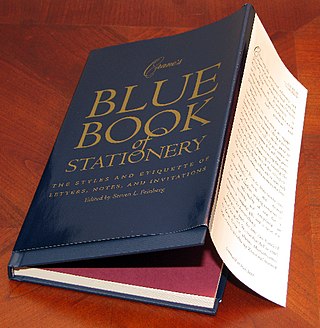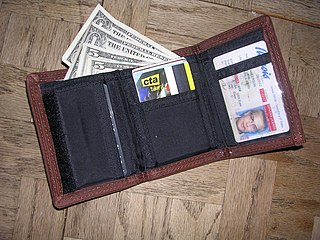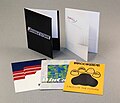Electronic data interchange (EDI) is the concept of businesses electronically communicating information that was traditionally communicated on paper, such as purchase orders, advance ship notices, and invoices. Technical standards for EDI exist to facilitate parties transacting such instruments without having to make special arrangements.
Desktop publishing (DTP) is the creation of documents using page layout software on a personal ("desktop") computer. It was first used almost exclusively for print publications, but now it also assists in the creation of various forms of online content. Desktop publishing software can generate layouts and produce typographic-quality text and images comparable to traditional typography and printing. Desktop publishing is also the main reference for digital typography. This technology allows individuals, businesses, and other organizations to self-publish a wide variety of content, from menus to magazines to books, without the expense of commercial printing.
HCL Notes and HCL Domino are the client and server, respectively, of a collaborative client-server software platform formerly sold by IBM, now by HCL Technologies.

An MFP, multi-functional, all-in-one (AIO), or multi-function device (MFD), is an office machine which incorporates the functionality of multiple devices in one, so as to have a smaller footprint in a home or small business setting, or to provide centralized document management/distribution/production in a large-office setting. A typical MFP may act as a combination of some or all of the following devices: email, fax, photocopier, printer, scanner.

Stationery refers to commercially manufactured writing materials, including cut paper, envelopes, writing implements, continuous form paper, and other office supplies. Stationery includes materials to be written on by hand or by equipment such as computer printers.

Business cards are cards bearing business information about a company or individual. They are shared during formal introductions as a convenience and a memory aid. A business card typically includes the giver's name, company or business affiliation and contact information such as street addresses, telephone number(s), fax number, e-mail addresses and website. Before the advent of electronic communication, business cards also included telex details. Now they may include social media addresses such as Facebook, LinkedIn and Twitter. Traditionally, many cards were simple black text on white stock, and the distinctive look and feel of cards printed from an engraved plate was a desirable sign of professionalism. In the late 20th century, technological advances drove changes in style, and today a professional business card will often include one or more aspects of striking visual design.

Accounts payable (AP) is money owed by a business to its suppliers shown as a liability on a company's balance sheet. It is distinct from notes payable liabilities, which are debts created by formal legal instrument documents. An accounts payable department's main responsibility is to process and review transactions between the company and its suppliers and to make sure that all outstanding invoices from their suppliers are approved, processed, and paid. The accounts payable process starts with collecting supply requirements from within the organization and seeking quotes from vendors for the items required. Once the deal is negotiated, purchase orders are prepared and sent. The goods delivered are inspected upon arrival and the invoice received is routed for approvals. Processing an invoice includes recording important data from the invoice and inputting it into the company's financial, or bookkeeping, system. After this is accomplished, the invoices must go through the company's respective business process in order to be paid.
In computers, a printer driver or a print processor is a piece of software on a computer that converts the data to be printed to a format that a printer can understand. The purpose of printer drivers is to allow applications to do printing without being aware of the technical details of each printer model.

The dust jacket of a book is the detachable outer cover, usually made of paper and printed with text and illustrations. This outer cover has folded flaps that hold it to the front and back book covers.

A wallet is a flat case or pouch, often used to carry small personal items such as paper currency, credit cards; identification documents such as driver's license, identification card, club card; photographs, transit pass, business cards and other paper or laminated cards. Wallets are generally made of leather or fabrics, and they are usually pocket-sized and foldable.
Records management, also known as records and information management, is an organizational function devoted to the management of information in an organization throughout its life cycle, from the time of creation or receipt to its eventual disposition. This includes identifying, classifying, storing, securing, retrieving, tracking and destroying or permanently preserving records. The ISO 15489-1: 2001 standard defines records management as "[the] field of management responsible for the efficient and systematic control of the creation, receipt, maintenance, use and disposition of records, including the processes for capturing and maintaining evidence of and information about business activities and transactions in the form of records".
Enterprise content management (ECM) extends the concept of content management by adding a timeline for each content item and, possibly, enforcing processes for its creation, approval, and distribution. Systems using ECM generally provide a secure repository for managed items, analog or digital. They also include one methods for importing content to bring manage new items, and several presentation methods to make items available for use. Although ECM content may be protected by digital rights management (DRM), it is not required. ECM is distinguished from general content management by its cognizance of the processes and procedures of the enterprise for which it is created.

A folding machine is a machine used primarily for the folding of paper. Folding is the sharp-edged bending of paper webs or sheets under pressure at a prepared or unprepared bending point along a straight line according to specified dimensions and folding layouts. Paper can be folded with either a buckle or a knife; thus, there are generally three types of folding machines: buckle folders, knife folders or a combination of these two types. Whilst buckle folding is the more popular of the two methods, knife folding is sometimes preferable. Folding machine models vary in sophistication, with high-end machines capable of processing more complex folding jobs and unusual paper forms. Organizations required to undertake mass mail-out campaigns often employ folding machines to improve efficiency. However it is very commonly used finishing process across the printing industry.

A file folder is a kind of folder that holds papers together for organization and protection. File folders usually consist of a sheet of heavy paper stock or other thin, but stiff, material which is folded in half, and are used to keep paper documents. Files may also contain other things like magazines, cased in music CDs, etc. sometimes mostly not used for any official use, rather used as normal storage in a home. They are often used in conjunction with a filing cabinet for storage. File folders can easily be purchased at office supply stores.

A brochure is a promotional document primarily used to introduce a company, organization, products, or services and inform prospective customers or members of the public of the benefits. Although, initially, a paper document that can be folded into a template, pamphlet, or leaflet, a brochure can also be a set of related unfolded papers put into a pocket folder or packet or can be in digital format.

Bookbinding is the process of building a book of codex manuscripts from an ordered stack of paper sheets with one's hands and tools. Firstly, one binds the sheets of papers along an edge with a thick needle and strong thread. One can also use loose-leaf rings, binding posts, twin-loop spine coils, plastic spiral coils, and plastic spine combs, but they last for a shorter time. Next, one encloses the bound stack of paper in a cover. Finally, one places an attractive cover onto the boards, and features the publisher's information and artistic decorations.
Document Capture Software refers to applications that provide the ability and feature set to automate the process of scanning paper documents or importing electronic documents, often for the purposes of feeding advanced document classification and data collection processes. Most scanning hardware, both scanners and copiers, provides the basic ability to scan to any number of image file formats, including: PDF, TIFF, JPG, BMP, etc. This basic functionality is augmented by document capture software, which can add efficiency and standardization to the process.

Promotional merchandise are products branded with a logo or slogan and distributed at little or no cost to promote a brand, corporate identity, or event. Such products, which are often informally called promo products, swag, tchotchkes, or freebies, are used in marketing and sales. They are given away or sold at a loss to promote a company, corporate image, brand, or event. They are often distributed as handouts at trade shows, at conferences, on sales calls, and as bonus items in shipped orders. They are often used in guerrilla marketing campaigns.
Discoverability is the degree to which something, especially a piece of content or information, can be found in a search of a file, database, or other information system. Discoverability is a concern in library and information science, many aspects of digital media, software and web development, and in marketing, since products and services cannot be used if people cannot find it or do not understand what it can be used for.
Plastic-coated paper is a coated or laminated composite material made of paper or paperboard with a plastic layer or treatment on a surface. This type of coated paper is most used in the food and drink packaging industry.














